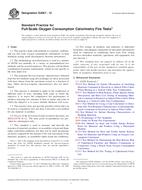Potrebujeme váš súhlas na využitie jednotlivých dát, aby sa vám okrem iného mohli ukazovať informácie týkajúce sa vašich záujmov. Súhlas udelíte kliknutím na tlačidlo „OK“.
ASTM E2067-12
Standard Practice for Full-Scale Oxygen Consumption Calorimetry Fire Tests
Automaticky preložený názov:
Štandardné praktiky pre Full-Scale Oxygen Spotreba kalorimetria požiarnej skúšky
NORMA vydaná dňa 15.12.2012
Informácie o norme:
Označenie normy: ASTM E2067-12
Poznámka: NEPLATNÁ
Dátum vydania normy: 15.12.2012
Kód tovaru: NS-44176
Počet strán: 24
Približná hmotnosť: 72 g (0.16 libier)
Krajina: Americká technická norma
Kategória: Technické normy ASTM
Anotácia textu normy ASTM E2067-12 :
Keywords:
calorimetry, fire, full-scale test, heat release, oxygen consumption, smoke, ICS Number Code 17.200.20 (Temperature-measuring instruments)
Doplňujúce informácie
| Significance and Use | ||||||||||||||||||||||||||||||||||||||||||||||||||||||
|
4.1 The oxygen consumption principle, used for the measurements described here, is based on the observation that, generally, the net heat of combustion is directly related to the amount of oxygen required for combustion 4.1.1 This technique is not appropriate for use on its own when the combustible fuel is an oxidizer or an explosive agent, which release oxygen. Further analysis is required in such cases (see Appendix X2). 4.2 The heat release is determined by the measurement of the oxygen consumption, as determined by the oxygen concentration and the flow rate in the combustion product stream, in a full scale environment. 4.3 The primary measurements are oxygen concentration and exhaust gas flow rate. Additional measurements include the specimen ignitability, the smoke obscuration generated, the specimen mass loss rate, the effective heat of combustion and the yields of combustion products from the test specimen. 4.4 The oxygen consumption technique is used in different types of test methods. Intermediate scale (Test Method E1623, UL 1975) and full scale (Test Method D5424, Test Method D5537, Test Method E1537, Test Method E1590, Test Method E1822, ISO 9705, NFPA 265, NFPA 266, NFPA 267, NFPA 286, UL 1685) test methods, as well as unstandardized room scale experiments following Guide E603, using this technique involve a large instrumented exhaust hood, where oxygen concentration is measured, either standing alone or positioned outside a doorway. A large test specimen is placed either under the hood or inside the room. This practice is intended to address issues associated with equipment requiring a large instrumented hood and not stand-alone test apparatuses with small test specimens. 4.4.1 Small scale test methods using this technique, such as Test Methods D6113, E1354, E1474 and E1740, as well as ISO 5660 internationally, are based on a stand-alone apparatus, wherein a small specimen is tested within the equipment. 4.4.2 Another small scale heat release test method, Test Method E906, does not use the oxygen consumption technique. 4.5 Throughout this practice, test equipment is referenced to provide helpful guidance to test facilities. Substitution of equivalent, or better, test measuring devices is permissible. |
||||||||||||||||||||||||||||||||||||||||||||||||||||||
| 1. Scope | ||||||||||||||||||||||||||||||||||||||||||||||||||||||
|
1.1 This practice deals with methods to construct, calibrate, and use full scale oxygen consumption calorimeters to help minimize testing result discrepancies between laboratories. 1.2 The methodology described herein is used in a number of ASTM test methods, in a variety of unstandardized test methods, and for research purposes. This practice will facilitate coordination of generic requirements, which are not specific to the item under test. 1.3 The principal fire-test-response characteristics obtained from the test methods using this technique are those associated with heat release from the specimens tested, as a function of time. Other fire-test-response characteristics also are determined. 1.4 This practice is intended to apply to the conduction of different types of tests, including both some in which the objective is to assess the comparative fire performance of products releasing low amounts of heat or smoke and some in which the objective is to assess whether flashover will occur. 1.5 This practice does not provide pass/fail criteria that can be used as a regulatory tool, nor does it describe a test method for any material or product. 1.6 For use of the SI system of units in referee decisions, see IEEE/ASTM SI-10,. The units given in parentheses are provided for information only. 1.7 This standard is used to measure and describe the response of materials, products, or assemblies to heat and flame under controlled conditions, but does not by itself incorporate all factors required for fire hazard or fire risk assessment of the materials, products, or assemblies under actual fire conditions. 1.8 Fire testing of products and
materials is inherently hazardous, and adequate safeguards for
personnel and property shall be employed in conducting these tests.
Fire testing involves hazardous materials, operations, and
equipment. See also Section 7.
1.9 This standard does not purport to address all of the safety concerns, if any, associated with its use. It is the responsibility of the user of this standard to establish appropriate safety and health practices and determine the applicability of regulatory limitations prior to use. |
||||||||||||||||||||||||||||||||||||||||||||||||||||||
| 2. Referenced Documents | ||||||||||||||||||||||||||||||||||||||||||||||||||||||
|
Odporúčame:
Aktualizácia technických noriem
Chcete mať istotu, že používate len platné technické normy?
Ponúkame Vám riešenie, ktoré Vám zaistí mesačný prehľad o aktuálnosti noriem, ktoré používate.
Chcete vedieť viac informácií ? Pozrite sa na túto stránku.




 Cookies
Cookies
